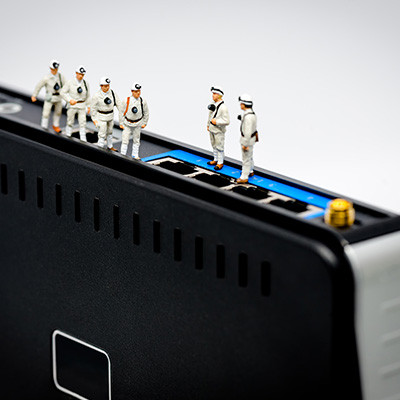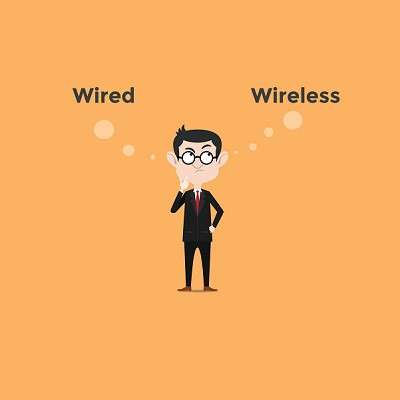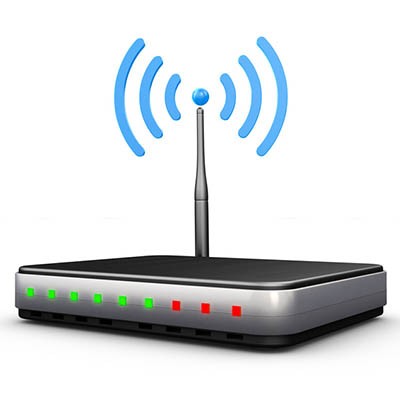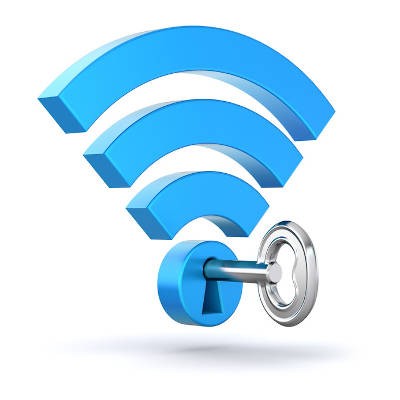Make no mistake about it, connectivity to the Internet is paramount for any business. A surefire way to gauge this importance is to observe people's reactions when they are informed that the Wi-Fi will be down for a few hours. In such a context, businesses face a crucial decision: should they opt for wired connections or embrace robust Wi-Fi? To make an informed choice, it's essential to understand the benefits associated with both options.
The Connection, Inc Blog
There are times when people take their technology for granted. One of the most under-the-radar, yet still critical parts of a business’ technology infrastructure is the networking equipment. By this we mean the hardware that connects your business to the Internet and to your network. We are talking cables, switches, and routers. This month, we will take a look at typical office networking found in 2020 and the technologies that are primed to replace them.
Businesses’ data needs are rapidly changing. Today, data security is a pressing issue. Unfortunately, the amount of dangerous threats are expanding as well and it is important to ensure that any technology moves you make don’t end up putting your business in harm’s way. This month, we’ll talk about the pros and cons of wiring up your computer network.
You might know your Wi-Fi password, but can you tell your new staff members, guests, and clients, what it is off the top of your head? If you don’t write your password down, or store it somewhere that’s easily accessible, it can be difficult to remember; especially if it’s long and complex like it should be. Thankfully, if you already have a computer connected to the network, you can easily find out what your Wi-Fi password is.
Today’s business relies on mobile devices, like smartphones, to guide them to productivity and efficiency. In fact, the vast majority of people in today’s society own a smartphone. A report shows that 90 percent of people younger than 30 own a smartphone, which means that the forward-thinking business hiring talented millennials may want to start thinking about how to secure any mobile devices that they use to access company data.
Wi-Fi has been one of the single most useful innovations for the modern office. Connecting to your Internet without having to be physically connected to it via an ethernet wire has been an incredibly freeing process--one that opens up all sorts of possibilities of where (and how) you can get work done. How can you make sure that your Wi-Fi signals are as clear and reliable as possible?
The unfortunate part of Wi-Fi is that it’s so commonplace, people expect it to always be available, 100 percent of the time. Even the slightest interruption is enough to throw some folks into a frenzy. Perhaps you’ve experienced something like this yourself when your Internet at home is down in the middle of your favorite television show. In the workplace, a loss of Wi-Fi can contribute to far bigger problems than catching up on your soaps. Instead, it can mean a loss of productivity--a form of downtime that can cost your organization significantly.
There are countless benefits to keeping your Wi-Fi network both accessible and fast for your employees. In fact, 42 percent of employees have found that it’s a major contributing factor toward greater productivity in the workplace. This reason alone is enough to consider just how fast and reliable your own Wi-Fi connection is, as well as taking steps toward making it even better than before. Here are some ways that your organization can improve the quality of your Wi-Fi connection.
- Test your speed: Before you can improve your speed, it’s crucial that you test it to see if it really needs improving. To do this, you can work with your ISP or run one of the assorted speed tests that you can find on the Internet.
- Find the peaks and valleys: Once you know the Wi-Fi speed that you can expect, you can use this information to find out where your organization’s connection is strongest and weakest. A heatmapping application on your smartphone makes this process easier as well.
- Reconfiguring your router: Your router could also be the cause of your wireless troubles. You can access your router’s dashboard through your computer’s web browser, allowing you to reconfigure it as needed. Of course, before you make any crazy changes to it, you should first discuss the changes with your IT provider.
- Replacing your router: If your router is simply too old to be effective for your business’ needs, you can replace it. Remember that your technology should evolve and adapt as your organization does. If your router is older, it doesn’t necessarily have the most up-to-date wireless standards in place.
- Check for firmware updates: If your router has outdated firmware installed, then it has plenty of untapped potential that you might not immediately notice. To access this potential, visit the manufacturer’s website and download the latest firmware. Again, it’s critical that you consult IT before doing this.
- Move your router: Use your heatmapping tool to find the best place for your router. Doing so can help you improve signal strength throughout your space.
To learn more about how your business can improve Wi-Fi strength and signal, reach out to us at (732) 291-5938.
Wireless Internet access for a user’s devices isn’t just a luxury these days--it’s expected. If the Wi-Fi drops out for any reason at all, chaos strikes, rendering any ability to stream content or access the Internet a moot point. This is particularly the case for businesses that have technology solutions reliant on wireless access. How can you make sure your wireless network is as strong and reliable as possible?
A More Flexible Workplace
Take a moment to reflect on the devices used by your business. If it’s like more modern offices, you have employees using mobile devices or laptops more often than you see them using their desktop workstations. Employees simply like to have their options open in the office, and a strong wireless connection helps to make this possible. If you give your organization’s employees the ability to get work done on their own terms, you can empower them to be more productive with their time in the workplace.
Uptime is Maximized
Losing an Internet signal isn’t just annoying--it can be a major detriment to your organization’s success. Any situation when your business isn’t functioning as it’s supposed to be can be considered downtime, and it can be a major setback for any organization hoping to improve their bottom line. Think about it this way: if your business’ employees can’t work because the Internet is down, and they are still in the office waiting for it to return, then you’re paying them to do nothing--not exactly the most effective use of your operational funds. Ensuring a strong connection can reduce this risk considerably.
Distance from the Router Won’t Matter (As Much)
Sometimes an office is so big that it needs multiple wireless routers to ensure all employees have access to the network. Therefore, a solid connection can go a long way toward minimizing the influence that your office’s setup has on your employees’ Internet connection. There are issues that can get in the way and cause interference, but if your connection is strong thanks to a solid wireless router, you won’t have to worry as much about it.
To find out how The Connection, Inc can help your business maintain a steady wireless connection, reach out to us at (732) 291-5938.
Maintaining network security is always a priority for the security-minded company, but if your organization’s strategy is to fly under the radar, you need a new plan. No business is too small to be a victim of a network breach. What most people who are tasked with coming up with a network security strategy for a small business don’t always realize is that threats are everywhere. Today, we’re going to take a look at planning a secure and reliable Wi-Fi strategy that doesn’t inherently add to your business’ risk.
It isn’t always the IT department that pushes for wireless network implementation, but it continues to happen at most places of business. Luckily for all parties, today’s wireless internet is easier to install, is faster than ever, and works to protect network security better than ever before, once it is set up correctly. Let’s go step-by-step.
Step #1 - Identify Need
There are very distinct pros and cons to implementing a wireless network for your business. On one hand a wireless network is much more cost effective. It enhances mobility, which can fuel a more flexible and collaborative work environment. These are two very good reasons to implement one, but there are some detriments, especially considering security. It’s true that data sent over a Wi-Fi connection is more susceptible to threat than through a wired connection. Luckily, wireless is more secure than it was in the past, but knowing you will have to keep a more vigilant eye on wirelessly transmitted data is a consideration you have to account for.
Step #2 - Coverage Area
Supposing that you do see the benefits in implementing a wireless network, the next step is to identify what area needs to be covered by the wireless network. Do you want your Wi-Fi to reach outside the confines of your building? Ideally, you will want to examine just where you need coverage and come up with a general idea where your access points will be.
Step #3 - Bandwidth
Before you can start building your Wi-Fi network you need to determine how much bandwidth you are going to need to facilitate the users on your new wireless network. Are your users bandwidth-hungry? Are they using cloud platforms or uploading and downloading data constantly? Estimating your organization's bandwidth needs will go a long way toward dictating how many access points are needed.
Step #4 - Hardware
The hardware you will need to implement your new Wi-Fi network is minimal, but identifying exactly what you need to fuel the platform you’ve planned is a big step. Part of selecting the hardware you need is deciding which wireless standard to follow. Of course, there is some interoperability between standards, but for your business’ benefit, planning on using a single standard is best practice. The most prevalent for high speed wireless transmission are 802.11a and 802.11g. 802.11b delivers slower Internet speeds, but also reduces the prices of the hardware substantially.
Step #5 - Implementation
Setting up the network may be more work than you may think, but it’s true that some places can just put a single wireless router on the wall next to the modem and cover everything the business needs it to cover. If this doesn’t describe your business, you will want to do a site survey to test the Wi-Fi’s reach so you can put the hardware in the right spots.
Step #6 - Security
Before you let anyone access your new Wi-Fi network, you will absolutely want to set up the security you plan on using. At The Connection, Inc, we suggest that you consult an IT expert when implementing security. This is because as much as you can understand the best practices needed to control a system’s security, an expert has the experience needed to set up the network security options properly, and can work to integrate it with your other network security efforts.
If you insist on doing this type of thing yourself, there are a couple of things you need to do. They include:
- Change your router’s admin password - The first step in most security practices is changing the password. It is no different here.
- Turn off Service Set Identifier (SSID) broadcasting - This doesn’t allow passersby to see that your wireless network is up and available.
- Change default SSID - Since a lot of factory-provided SSID values are available, you can avoid them altogether by changing the SSID login name.
- Enable MAC address filtering - This gives you control over which users have access to what access points.
- Add EAP authentication and enable encryption - Requires secure authentication from each user on the network.
- Consider virtual private networking - If you need extra security, a virtual private network connection can provide access to your network when you are out of the WLAN’s reach.
Step #7 - Deploy
Once your Wi-Fi is properly secured, it is time to start adding your users to it. Again, the technicians at The Connection, Inc can save a lot of time and effort with the management of this process. Our team would be able to properly set up the secure Wi-Fi network using the SSID information and the MAC address filter that was set up earlier, effectively whitelisting the devices you want to allow, instead of blacklisting all the devices you don’t.
If you would like help setting up your business’ Wi-Fi connection call the experts at The Connection, Inc today at (732) 291-5938.
Wi-Fi has swiftly become one of those amenities that we just expect to have, including in the workplace. While it does make work around the office more convenient, it should not be at the cost of your security. To help prevent this, we’re reviewing a few key Wi-Fi security considerations to keep in mind.
Don’t Rely On It For Your Security
Regardless of how secure your network purports to be, it doesn’t hurt to continue subscribing to best practices when it comes to maintaining your security -- in fact, it could very well hurt you not to do so. Wi-Fi in particular isn’t the most secure method to use out of the box, so you should always be sure to support what you use with additional protections and security measures. For example, you should always incorporate encryption to help protect your traffic, something that you need to make sure is done, because your traffic won’t be secure otherwise.
You should also follow general browsing best practices at all times, just as an added precaution. Avoid websites that lack the ‘s’ in https, as that ‘s’ stands for secure.
Protect Your Wi-Fi With Good Passphrases and Practices
At this point, most people are at least aware of what makes a bad password: the usual suspects, including:
- Simple and common words and letter combinations being used
- No variation in character type
- Reusing the same password for different sets of credentials
- Passwords written down on scrap paper or sticky notes
This is just a small sample of all the little habits and shortcuts that users will understandably start to pick up to make sure that they can remember all of the different passwords they need to maintain (not to mention the idea that they should use a different password for each account).
While your employees certainly shouldn’t be shortchanging your security measures, they are only human. One way to compromise with them (without compromising your security) is to use passphrases instead of passwords, creating a very bland sentence and using that as your authentication proof instead - something like “ipourthemilkintothecereal.” Memorable, yes, but certainly not well-known. Naturally, these should be kept confidential, and it will probably help to use a password manager to keep track of them. On top of that, add numbers, symbols, and capitalization.
Consider Your Wi-Fi Network
There are many ways that you can help increase the safety of your wireless network. Here are some quick highlights:
- Change your SSID away from the factory default to a unique but unrevealing alternative, even if you keep your network hidden.
- If a device has Wi-Fi capabilities that you are not actively using, make sure that the device is off to help truncate the amount of access points you have into your wireless network. If a device can be connected to your network via ethernet, consider doing so.
- Keep business use of the network separate from any guest use of the network with a dedicated guest network, protected by a simple passphrase that you update periodically. Turn off the guest network whenever it is not needed for added security.
Want extra help with any of these security considerations? Trust the experts at The Connection, Inc! We can help keep your technology safe for you to continue your business operations with it in your corner. Call (732) 291-5938 to learn more.
Did you know that prior to this past January, the last big update to Wi-Fi occurred in 2004, when WPA2 was released? The Wi-Fi alliance has introduced a new type of wireless connection called WPA3--one that can dramatically improve security. In reality, it was created with the intention of shoring up weaknesses found as a result of the KRACK vulnerability, which exposed serious issues with WPA2 that needed to be addressed.
 It seems like just yesterday that the world adopted 4G as the accepted model of wireless technology communication, but it’s still important to look toward the future and push for greater heights. Wireless technology has permeated society to the point where it’s steeped with smartphones and other mobile devices. So, what’s next in the wireless game?
It seems like just yesterday that the world adopted 4G as the accepted model of wireless technology communication, but it’s still important to look toward the future and push for greater heights. Wireless technology has permeated society to the point where it’s steeped with smartphones and other mobile devices. So, what’s next in the wireless game?










